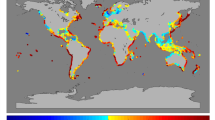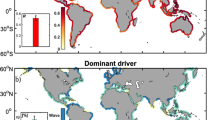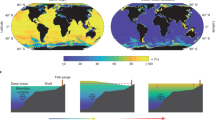Abstract
Coastal communities are threatened by sea-level changes operating at various spatial scales; global to regional variations are associated with glacier and ice sheet loss and ocean thermal expansion, while smaller coastal-scale variations are also related to atmospheric surges, tides and waves. Here, using 23 years (1993–2015) of global coastal sea-level observations, we examine the contribution of these latter processes to long-term sea-level rise, which, to date, have been relatively less explored. It is found that wave contributions can strongly dampen or enhance the effects of thermal expansion and land ice loss on coastal water-level changes at interannual-to-multidecadal timescales. Along the US West Coast, for example, negative wave-induced trends dominate, leading to negative net water-level trends. Accurate estimates of past, present and future coastal sea-level rise therefore need to consider low-frequency contributions of wave set-up and swash.
This is a preview of subscription content, access via your institution
Access options
Access Nature and 54 other Nature Portfolio journals
Get Nature+, our best-value online-access subscription
$29.99 / 30 days
cancel any time
Subscribe to this journal
Receive 12 print issues and online access
$209.00 per year
only $17.42 per issue
Buy this article
- Purchase on Springer Link
- Instant access to full article PDF
Prices may be subject to local taxes which are calculated during checkout




Similar content being viewed by others
Change history
23 July 2018
In the version of this Article originally published, there were a number of errors in the main text, the Supplementary Information, the Methods and Figures that needed to be corrected as a result of a coding error when quantifying the wave contributions to sea level rise. In the ‘Interannual-to-multidecadal changes’ section of the main text, from the sentence beginning “Overall, the median...”, ‘55%’ has been corrected to ‘58%’; in the following sentence, “This large contribution is globally evenly distributed...” has been adjusted to “This large contribution is distributed...”, and ‘28%’ and ‘27%’ have been corrected to ‘38%’ and ‘20%’, respectively; and in the sentence following that, ‘39%’ and ‘16%’ have been corrected to ‘36%’ and ‘17%’, respectively. In the ‘Sensitivity to the wave set-up and swash formulation.’ section of the Methods, in equation (5), ’0.756’, ‘0.165’ and ‘0.0368’ have been corrected to ‘0.757’, ‘0.167’ and ‘0.044 H02’, respectively; in the sentence beginning ‘Wave contribution to...’, ‘55%’ has been corrected to ‘28%’; the following sentence has been corrected to read: “On average, swell contribution to the total wave contribution are of 64% for all three formulations.”; and in the final sentence, ‘(i) (49% and 51%...)’ has been corrected to ‘(ii) (41% and 59%...)’, ‘(iii) (36% and 64%...)’ has been corrected to ‘(i) (34% and 66%...)’, and ‘(ii) (19% and 81%...)’ has been corrected to ‘(iii) (25% and 75%...)’. In the ‘Significance of the trends.’ section of the Methods, in the final sentence '(Galápagos Islands, Callao, Clipperton Island and Tumaco)...' has been corrected to read '(Galápagos Islands and Tumaco)…'. In the online versions of the article, Figs 2–4 and Supplementary Figs 2–9 have been replaced to correct erroneous results that were the consequence of the coding error. All these figures are available as Supplementary Information to this correction notice.
References
Wong, P. P. et al. In Climate Change 2014: Impacts, Adaptation, and Vulnerability (eds Field, C. B. et al.) 361–409 (IPCC, Cambridge Univ. Press, 2014).
Hallegatte, S., Green, C., Nicholls, R. J. & Corfee-Morlot, J. Future flood losses in major coastal cities. Nat. Clim. Change 3, 802–806 (2013).
Nicholls, R. J. & Cazenave, A. Sea-level rise and its impact on coastal zones. Science 328, 1517–1520 (2010).
Brown, S. et al. In Coastal Hazards 117–149 (Springer, Dordrecht, 2013).
McGranahan, G., Balk, D. & Anderson, B. The rising tide: assessing the risks of climate change and human settlements in low elevation coastal zones. Environ. Urban. 19, 17–37 (2007).
Hugo, G. Future demographic change and its interactions with migration and climate change. Glob. Environ. Change 21, S21–S33 (2011).
IPCC Climate Change 2013: The Physical Science Basis (eds Stocker, T. F. et al.) Ch. 13 (Cambridge Univ. Press, 2013).
Slangen, A. B. et al. Evaluating model simulations of twentieth-century sea level rise. Part I: Global mean sea level change. J. Clim. 30, 8539–8563 (2017).
Forget, G. & Ponte, R. M. The partition of regional sea level variability. Progress. Oceanogr. 137, 173–195 (2015).
Meyssignac, B. et al. Evaluating model simulations of twentieth-century sea-level rise. Part II: Regional sea-level changes. J. Clim. 30, 8565–8593 (2017).
Tamisiea, M. E. Ongoing glacial isostatic contributions to observations of sea level change. Geophys. J. Int. 186, 1036–1044 (2011).
Sallenger, A. H. Storm impact scale for barrier islands. J. Coast. Res. 16, 890–895 (2000).
Muis, S., Verlaan, M., Winsemius, H. C., Aerts, J. C. & Ward, P. J. A global reanalysis of storm surges and extreme sea levels. Nat. Commun. 7, 11969 (2016).
Woodworth, P. L. et al. Towards a global higher-frequency sea level dataset. Geosci. Data J. 3, 50–59 (2016).
Woodworth, P., Gregory, J. & Nicholls, R. in The Sea (eds Robinson, A. R. & Brink, K.) Vol. 13 (Harvard Univ. Press: Harvard, 2004).
Vitousek, S. et al. Doubling of coastal flooding frequency within decades due to sea-level rise. Sci. Rep. 7, 1399 (2017).
Serafin, K. A., Ruggiero, P. & Stockdon, H. F. The relative contribution of waves, tides, and non-tidal residuals to extreme total water levels on US West Coast sandy beaches. Geophys. Res. Lett. 44, 1839–1847 (2017).
Rueda, A. et al. Global classification of coastal flooding climates. Sci. Rep. 7, 5038 (2017).
Ruggiero, P. Is the intensifying wave climate of the US Pacific Northwest increasing flooding and erosion risk faster than sea level rise? J. Waterw. Port. Coast. Ocean Eng. 139, 88–97 (2013).
Nicholls, R. J. et al. Sea-level scenarios for evaluating coastal impacts. WIREs Clim. Change 5, 129–150 (2014).
Semedo, A., Suselj, K., Rutgersson, A. & Sterl, A. A global view on the wind sea and swell climate and variability from ERA-40. J. Clim. 24, 1461–1479 (2011).
Young, I. R., Zieger, S. & Babanin, A. V. Global trends in wind speed and wave height. Science 332, 451–455 (2011).
Hemer, M. A., Fan, Y., Mori, N., Semedo, A. & Wang, X. L. Projected future changes in wind-wave climate in a multi-model ensemble. Nat. Clim. Change 3, 471–476 (2013).
Wang, X. L., Feng, Y. & Swail, V. R. Changes in global ocean wave heights as projected using multimodel CMIP5 simulations. Geophys. Res. Lett. 41, 1026–1034 (2014).
Cazenave, A. et al. The rate of sea-level rise. Nat. Clim. Change 4, 358–361 (2014).
Ablain, M. et al. Improved sea level record over the satellite altimetry era (1993–2010) from the Climate Change Initiative project. Ocean Sci. 11, 67–82 (2015).
Cipollini, P., Calafat, F. M., Jevrejeva, S., Melet, A. & Prandi, P. Monitoring sea level in the coastal zone with satellite altimetry and tide gauges. Surv. Geophys. 38, 33–57 (2017).
Birol, F. et al. Coastal applications from nadir altimetry: example of the X-TRACK regional products. Adv. Space Res. 59, 936–953 (2017).
Thompson, R. O. & Hamon, B. V. Wave setup of harbor water levels. J. Geophys. Res. 85, 1151–1152 (1980).
Hoeke, R. K. et al. Widespread inundation of Pacific islands triggered by distant-source wind-waves. Glob. Planet. Change 108, 128–138 (2013).
Hoeke, R. K., McInnes, K. L. & O’Grady, J. G. Wind and wave setup contributions to extreme sea levels at a tropical high island: a stochastic cyclone simulation study for Apia, Samoa. J. Mar. Sci. Eng. 3, 1117–1135 (2015).
Melet, A., Almar, R. & Meyssignac, B. What dominates sea level at the coast: a case study for the Gulf of Guinea. Ocean Dyn. 66, 623–636 (2016).
Carrère, L., Lyard, F., Cancet, M., Guillot, A. & Roblou, L. FES2012: a new global tidal model taking advantage of nearly 20 years of altimetry. In Proc. 20 Years Prog. Radar Altimetry Symp. (ed. Ouwehand, L.) 710–781 (European Space Agency, Noordwijk, 2013).
Carrère, L. & Lyard, F. Modeling the barotropic response of the global ocean to atmospheric wind and pressure forcing‐comparisons with observations. Geophys. Res. Lett. 30, 1275 (2003).
Dee, D. P. et al. The ERA-Interim reanalysis: configuration and performance of the data assimilation system. Q. J. R. Meteorol. Soc. 137, 553–597 (2011).
Stockdon, H. F., Holman, R. A., Howd, P. A. & Sallenger, A. H. Empirical parameterization of setup, swash, and runup. Coast. Eng. 53, 573–588 (2006).
Caldwell, P. C., Merrifield, M. A. & Thompson, P. R. Sea Level Measured by Tide Gauges from Global Oceans—the Joint Archive for Sea Level Holdings (NCEI Accession 0019568) Version 5.5 (NOAA National Centers for Environmental Information, 2015).
Merrifield, M. A., Genz, A. S., Kontoes, C. P. & Marra, J. J. Annual maximum water levels from tide gauges: contributing factors and geographic patterns. J. Geophys. Res. 118, 2535–2546 (2013).
Roberts, C. et al. On the drivers and predictability of seasonal-to-interannual variations in regional sea level. J. Clim. 29, 7565–7585 (2016).
Bilbao, R. A. F., Gregory, J. M. & Bouttes, N. Analysis of the regional pattern of sea level change due to ocean dynamics and density change for 1993–2099 in observations and CMIP5 AOGCMs. Clim. Dyn. 45, 2647–2666 (2015).
Piecuch, C. G. & Ponte, R. M. Buoyancy-driven interannual sea level changes in the tropical South Atlantic. J. Phys. Oceanogr. 43, 533–547 (2013).
Almar, R. et al. Response of the Bight of Benin (Gulf of Guinea, West Africa) coastline to anthropogenic and natural forcing, part 1: wave climate variability and impacts on the longshore sediment transport. Cont. Shelf Res. 110, 48–59 (2015).
Woodworth, P. L. A note on the nodal tide in sea level records. J. Coast. Res. 28, 316–323 (2012).
Swart, N. C. & Fyfe, J. C. Observed and simulated changes in the Southern Hemisphere surface westerly wind-stress. Geophys. Res. Lett. 39, L16711 (2012).
Merrifield, M. A., Thompson, P. R. & Lander, M. Multidecadal sea level anomalies and trends in the western tropical Pacific. Geophys. Res. Lett. 39, L13602 (2012).
Bengtsson, L., Hodges, K. & Keenlyside, N. Will extratropical storms intensify in a warmer climate? J. Clim. 22, 2276–2301 (2009).
Takahashi, C. & Watanabe, M. Pacific trade winds accelerated by aerosol forcing over the past two decades. Nat. Clim. Change 6, 768–772 (2016).
Slangen, A. B. A. et al. Projecting twenty-first century regional sea-level changes. Clim. Change 124, 317–332 (2014).
Vousdoukas, M. I., Mentaschi, L., Voukouvalas, E., Verlaan, M. & Feyen, L. Extreme sea levels on the rise along Europe’s coasts. Earth’s Future 5, 304–323 (2017).
Arns, A. et al. Sea-level rise induced amplification of coastal protection design heights. Sci. Rep. 7, 40171 (2017).
Pujol, M. I. et al. DUACS DT2014: the new multi-mission altimeter data set reprocessed over 20 years. Ocean Sci. 12, 1067–1090 (2016).
Merrifield, M. A., Becker, J. M., Ford, M. & Yao, Y. Observations and estimates of wave-driven water level extremes at the Marshall Islands. Geophys. Res. Lett. 41, 7245–7253 (2014).
Ardhuin, F. & Roland, A. Coastal wave reflection, directional spread, and seismoacoustic noise sources. J. Geophys. Res. 117, C00J20 (2012).
Idier, D., Paris, F., Le Cozannet, G., Boulahya, F. & Dumas, F. Sea-level rise impacts on the tides of the European Shelf. Cont. Shelf Res. 137, 56–71 (2017).
Stopa, J. E. & Cheung, K. F. Intercomparison of wind and wave data from the ECMWF Reanalysis Interim and the NCEP Climate Forecast System Reanalysis. Ocean Model. 75, 65–83 (2014).
Wang, X. L. & Swail, V. R. Climate change signal and uncertainty in projections of ocean wave heights. Clim. Dyn. 26, 109–126 (2006).
Hemer, M. A. Historical trends in Southern Ocean storminess: long-term variability of extreme wave heights at Cape Sorell, Tasmania. Geophys. Res. Lett. 37, L18601 (2010).
Komar, P. Beach Processes and Sedimentation. 2nd ed. (Prentice Hall, Upper Saddle River, 1998).
Holman, R. & Sallenger, A. Setup and swash on a natural beach. J. Geophys. Res. 90, 945–953 (1985).
Stockdon, H. F. & Holman, R. A. Estimation of wave phase speed and nearshore bathymetry from video imagery. J. Geophys. Res. 105, 22015–22033 (2000).
Di Leonardo, S. & Ruggiero, P. Regional scale sandbar variability: observations from the US Pacific Northwest. Cont. Shelf Res. 95, 74–88 (2015).
Dangendorf, S. et al. Evidence for long-term memory in sea level. Geophys. Res. Lett. 41, 5530–5537 (2014).
Von Storch, H. & Zwiers, F. Statistical Analysis in Climate Research (Cambridge Univ. Press, Cambridge, 1999).
Acknowledgements
The authors are grateful to all people and institutions who provided data used in this study, including F. Lyard for providing FES2014 tidal data. R.A. received support from French grants through ANR (COASTVAR ANR-14-ASTR-0019). B.M. and G.L.C. received funding from the ECLISEA (European advances on CLImate services for coasts and SEAs) project, funded through the ERA4CS (European Research Area for Climate Services) framework. This work was supported by the CNES (Centre National d'Etudes Spatiales). It is based on observations from the Topex/Poseidon and Jason 1/2 missions. This work is a contribution to the LEFE/IMPHALA project.
Author information
Authors and Affiliations
Contributions
A.M. performed the analysis, created all figures and wrote the early drafts and final version of the manuscript. A.M., B.M. and R.A. participated in the elaboration of the study and early drafts. R.A. computed the contributions from waves. All authors participated in the interpretation of the results, in text revisions and in the final versions of the manuscript.
Corresponding author
Ethics declarations
Competing interests
The authors declare no competing interests.
Additional information
Publisher’s note: Springer Nature remains neutral with regard to jurisdictional claims in published maps and institutional affiliations.
Supplementary information
Supplementary Information
Supplementary Figures 1–9 and Supplementary note
Rights and permissions
About this article
Cite this article
Melet, A., Meyssignac, B., Almar, R. et al. Under-estimated wave contribution to coastal sea-level rise. Nature Clim Change 8, 234–239 (2018). https://doi.org/10.1038/s41558-018-0088-y
Received:
Accepted:
Published:
Issue Date:
DOI: https://doi.org/10.1038/s41558-018-0088-y
This article is cited by
-
Global coastal wave storminess
Scientific Reports (2024)
-
Reply to: Coastal shoreline change assessments at global scales
Nature Communications (2024)
-
Assessment of satellite altimetry SWH measurements by in situ observations within 25 km from the coast
Ocean Dynamics (2024)
-
Storm identification for high-energy wave climates as a tool to improve long-term analysis
Climate Dynamics (2024)
-
Mean Sea Level Trends Based on Tide Gauge Records and Their Possible Morphological Effects on the Coastline of Southern Rio de Janeiro (SE Brazil)
Thalassas: An International Journal of Marine Sciences (2024)



